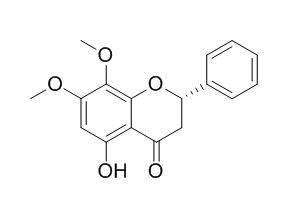5-Hydroxy-7,8-dimethoxyflavanone
5-Hydroxy-7,8-dimethoxyflavanone shows anti-inflammatory activity, it can significantly decrease TNF-alpha, IL-6, macrophage inflammatory protein-2 (MIP-2), and nitric oxide (NO) secretions from LPS/IFN-gamma stimulated RAW 264.7 cells. (2S)-5-Hydroxy-7,8-dimethoxyflavanone is weakly active against human nasopharyngeal carcinoma cell line (KB) with IC50 value at 12.86 ug/ml.
Inquire / Order:
manager@chemfaces.com
Technical Inquiries:
service@chemfaces.com
Tel:
+86-27-84237783
Fax:
+86-27-84254680
Address:
1 Building, No. 83, CheCheng Rd., Wuhan Economic and Technological Development Zone, Wuhan, Hubei 430056, PRC
Providing storage is as stated on the product vial and the vial is kept tightly sealed, the product can be stored for up to
24 months(2-8C).
Wherever possible, you should prepare and use solutions on the same day. However, if you need to make up stock solutions in advance, we recommend that you store the solution as aliquots in tightly sealed vials at -20C. Generally, these will be useable for up to two weeks. Before use, and prior to opening the vial we recommend that you allow your product to equilibrate to room temperature for at least 1 hour.
Need more advice on solubility, usage and handling? Please email to: service@chemfaces.com
The packaging of the product may have turned upside down during transportation, resulting in the natural compounds adhering to the neck or cap of the vial. take the vial out of its packaging and gently shake to let the compounds fall to the bottom of the vial. for liquid products, centrifuge at 200-500 RPM to gather the liquid at the bottom of the vial. try to avoid loss or contamination during handling.
Fitoterapia.2022, 105141.
Korea Institute of Oriental Medicine2020, doi: 10.21203.
J Korean Med Ophthalmol Otolaryngol Dermatol2023, 36(1):1-20.
Phytother Res.2022, ptr.7573.
Journal of Chromatography A2020, 460942
Expert Opin Ther Targets.2024, :1-11.
Braz J Med Biol Res. 2016, 49(7)
Dicle Tip Dergisi2020, 47(2),423-430.
J Pharm Biomed Anal.2021, 196:113931.
Planta Med.2022, a-1876-3009.
Related and Featured Products
Parasitol Res. 2014 Sep;113(9):3381-92. Epub 2014 Jul 13.
cture–function relationships of inhibition of mosquito cytochrome P450 enzymes by flavonoids of Andrographis paniculata.[Pubmed:
25015047]
The cytochrome P450 monooxygenases are known to play a major role in pyrethroid resistance, by means of increased rate of insecticide detoxification as a result of their overexpression. Inhibition of detoxification enzymes may help disrupting insect detoxifying defense system. The Anopheles minimus CYP6AA3 and CYP6P7 have shown pyrethroid degradation activity and been implicated in pyrethroid resistance.
METHODS AND RESULTS:
In this study inhibition of the extracts and constituents of Andrographis paniculata Nees. leaves and roots was examined against benzyloxyresorufin O-debenzylation (BROD) of CYP6AA3 and CYP6P7. Four purified flavones (5,7,4′-trihydroxyflavone, 5-hydroxy-7,8-dimethoxyflavone, 5-hydroxy-7,8,2′,3′-tetramethoxyflavone, and 5,4′-dihydroxy-7,8,2′,3′-tetramethoxyflavone), one flavanone (5-Hydroxy-7,8-dimethoxyflavanone) and a diterpenoid (14-deoxy-11,12-didehydroandrographolide) containing inhibitory effects toward both enzymes were isolated from A. paniculata. Structure–function relationships were observed for modes and kinetics of inhibition among flavones, while diterpenoid and flavanone were inferior to flavones. Docking of flavones onto enzyme homology models reinforced relationships on flavone structures and inhibition modes. Cell-based inhibition assays employing 3-(4,5-dimethylthiazol-2-y-l)-2,5-diphenyltetrazolium bromide (MTT) cytotoxicity assays revealed that these flavonoids efficiently increased susceptibility of CYP6AA3- and CYP6P7-expressing Spodoptera frugiperda (Sf9) cells to cypermethrin toxicity, due to inhibition effects on mosquito enzymes.
CONCLUSIONS:
Thus synergistic effects on cypermethrin toxicity of A. paniculata compounds as a result of enzyme inhibition could be useful for mosquito vector control and insecticide resistance management in the future.
J Agric Food Chem. 2010 Feb 24;58(4):2505-12.
Anti-inflammatory activity of new compounds from Andrographis paniculata by NF-kappaB transactivation inhibition.[Pubmed:
20085279]
Previous studies showed that the ethyl acetate (EtOAc) fraction of Andrographis paniculata (AP) possessed anti-inflammatory activity.
METHODS AND RESULTS:
This study further isolated these active compounds from bioactivity-guided chromatographic fractionation and identified eight pure compounds. Reporter gene assay indicated that 5-hydroxy-7,8-dimethoxyflavone (1), 5-Hydroxy-7,8-dimethoxyflavanone (2), a mix of beta-sitosterol (3a) and stigmasterol (3b), ergosterol peroxide (4), 14-deoxy-14,15-dehydroandrographolide (5), and a new compound, 19-O-acetyl-14-deoxy-11,12-didehydroandrographolide (6a), significantly inhibited the transcriptional activity of NF-kappaB in LPS/IFN-gamma stimulated RAW 264.7 macrophages (P < 0.05). The two most abundant compounds, 14-deoxy-11,12-didehydroandrographolide (7) and andrographolide (8), had less inhibitory activity but exerted greater inhibitory activity by hydrogenation, oxidation, or acetylation to become four derived compounds, 9, 10, 11, and 12.
CONCLUSIONS:
All of the compounds significantly decreased TNF-alpha, IL-6, macrophage inflammatory protein-2 (MIP-2), and nitric oxide (NO) secretions from LPS/IFN-gamma stimulated RAW 264.7 cells. Compounds 5, 11, and 12 exerted the strongest inhibitory effect on NF-kappaB-dependent transactivation in the RAW 264.7 cell, with IC(50) values of 2, 2.2, and 2.4 microg/mL, respectively, providing encouraging results for bioactive compound development.
Nat Prod Res. 2005 Apr;19(3):223-30.
A new bis-andrographolide ether from Andrographis paniculata nees and evaluation of anti-HIV activity.[Pubmed:
15702635]
METHODS AND RESULTS:
Novel bis-andrographolide ether (1) and six known compounds andrographolide, 14-deoxy-11,12-didehydroandrographolide, andrograpanin, 14-deoxyandrographolide, (+/-)-5-Hydroxy-7,8-dimethoxyflavanone, and 5-hydroxy-7,8-dimethoxyflavone have been isolated from the aerial parts of Andrographis paniculata and their structures were established by spectral data. All the isolates were tested for the anti-HIV and cytotoxic activity.



